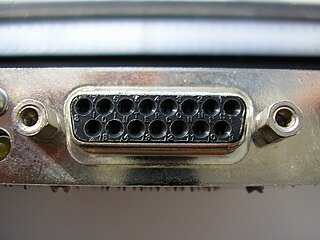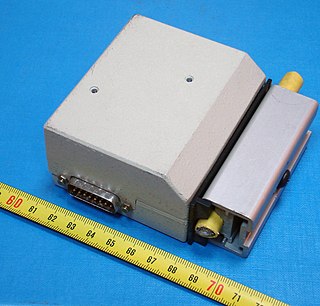AppleTalk is a discontinued proprietary suite of networking protocols developed by Apple Computer for their Macintosh computers. AppleTalk includes a number of features that allow local area networks to be connected with no prior setup or the need for a centralized router or server of any sort. Connected AppleTalk-equipped systems automatically assign addresses, update the distributed namespace, and configure any required inter-networking routing.

Network topology is the arrangement of the elements of a communication network. Network topology can be used to define or describe the arrangement of various types of telecommunication networks, including command and control radio networks, industrial fieldbusses and computer networks.

Apple Attachment Unit Interface (AAUI) is a mechanical re-design by Apple of the standard Attachment Unit Interface (AUI) used to connect computer equipment to Ethernet. The AUI was popular in the era before the dominance of 10BASE-T networking that started in the early 1990s; the AAUI was an attempt to make the connector much smaller and more user friendly, though the proprietary nature of the interface was also criticized.

On computers, a serial port is a serial communication interface through which information transfers in or out sequentially one bit at a time. This is in contrast to a parallel port, which communicates multiple bits simultaneously in parallel. Throughout most of the history of personal computers, data has been transferred through serial ports to devices such as modems, terminals, various peripherals, and directly between computers.

Apple Desktop Bus (ADB) is a proprietary bit-serial peripheral bus connecting low-speed devices to computers. It was introduced on the Apple IIGS in 1986 as a way to support low-cost devices like keyboards and mice, enabling them to be connected together in a daisy chain without the need for hubs or other devices. Apple Desktop Bus was quickly introduced on later Macintosh models, on later models of NeXT computers, and saw some other third-party use as well. Like the similar PS/2 connector used in many PC-compatibles at the time, Apple Desktop Bus was rapidly replaced by USB as that system became popular in the late 1990s; the last external Apple Desktop Bus port on an Apple product was in 1999, though it remained as an internal-only bus on some Mac models into the 2000s.

In telecommunication and data transmission, serial communication is the process of sending data one bit at a time, sequentially, over a communication channel or computer bus. This is in contrast to parallel communication, where several bits are sent as a whole, on a link with several parallel channels.
GeoPort is a serial data system used on some models of the Apple Macintosh that could be externally clocked to run at a 2 megabit per second data rate. GeoPort slightly modified the existing Mac serial port pins to allow the computer's internal DSP hardware or software to send data that, when passed to a digital-to-analog converter, emulated various devices such as modems and fax machines. GeoPort could be found on late-model 68K-based machines as well as many pre-USB Power Macintosh models and PiPPiN. Some later Macintosh models also included an internal GeoPort via an internal connector on the Communications Slot. Apple GeoPort technology is now obsolete, and modem support is typically offered through USB.

A registered jack (RJ) is a standardized telecommunication network interface for connecting voice and data equipment to a computer service provided by a local exchange carrier or long distance carrier. Registered interfaces were first defined in the Universal Service Ordering Code (USOC) system of the Bell System in the United States for complying with the registration program for customer-supplied telephone equipment mandated by the Federal Communications Commission (FCC) in the 1970s. They were subsequently codified in title 47 of the Code of Federal Regulations Part 68. Registered jack connections began to see use after their invention in 1973 by Bell Labs. The specification includes physical construction, wiring, and signal semantics. Accordingly, registered jacks are primarily named by the letters RJ, followed by two digits that express the type. Additional letter suffixes indicate minor variations. For example, RJ11, RJ14, and RJ25 are the most commonly used interfaces for telephone connections for one-, two-, and three-line service, respectively. Although these standards are legal definitions in the United States, some interfaces are used worldwide.

The Attachment Unit Interface (AUI) is a physical and logical interface defined in the original IEEE 802.3 standard for 10BASE5 Ethernet and the previous DIX standard. The physical interface consists of a 15-pin D-subminiature connection that provides a path between an Ethernet node's physical signaling and the Medium Attachment Unit (MAU), sometimes also known as a transceiver. An AUI cable may be up to 50 metres long, although frequently the cable is omitted altogether and the MAU and medium access controller MAC are directly attached to one another. On Ethernet implementations without separate MAU and MAC, the AUI is omitted.

RS-422, also known as TIA/EIA-422, is a technical standard originated by the Electronic Industries Alliance, first issued in 1975, that specifies electrical characteristics of a digital signaling circuit. It was meant to be the foundation of a suite of standards that would replace the older RS-232C standard with standards that offered much higher speed, better immunity from noise, and longer cable lengths. RS-422 systems can transmit data at rates as high as 10 Mbit/s, or may be sent on cables as long as 1,200 meters (3,900 ft) at lower rates. It is closely related to RS-423, which uses the same signaling systems but on a different wiring arrangement.

A Medium Attachment Unit (MAU) is a transceiver which converts signals on an Ethernet cable to and from Attachment Unit Interface (AUI) signals.

PhoneNET was an implementation of the AppleTalk networking physical layer created by Farallon Computing(now Netopia).
Farallon, later renamed Netopia, was a computer networking company headquartered in Berkeley, and subsequently Emeryville, California, that produced a wide variety of products including bridges, repeaters and switches, and in their later Netopia incarnation, modems, routers, gateways, and Wi-Fi devices. The company also produced the NBBS and, as Farallon, Timbuktu remote administration software, as well as the MacRecorder, the first audio capture and manipulation products for the Macintosh. The company was founded in 1986 and changed its name to Netopia in 1998. Farallon originated several notable technologies, including:

The PowerBook 500 series is a range of Apple Macintosh PowerBook portable computers first introduced by Apple Computer with the 540c model on May 16, 1994. It was the first to have stereo speakers, a trackpad, and Ethernet networking built-in.

A computer port is a hardware piece on a computer where an electrical connector can be plugged to link the device to external devices, such as another computer, a peripheral device or network equipment.

A modular connector is a type of electrical connector for cords and cables of electronic devices and appliances, such as in computer networking, telecommunication equipment, and audio headsets.

The GatorBox is a LocalTalk-to-Ethernet bridge, a router used on Macintosh-based networks to allow AppleTalk communications between clients on LocalTalk and Ethernet physical networks. The GatorSystem software also allowed TCP/IP and DECnet protocols to be carried to LocalTalk-equipped clients via tunneling, providing them with access to these normally Ethernet-only systems.

The Apple Communication Slot, or Comm Slot, is an internal expansion data interface (slot) found in Apple Macintosh computers from the early to mid-1990s. It was designed as an inexpensive way to add communication expansion cards like network adapters or modems to Macs and Power Macs.
TOPS is a peer-to-peer LAN-based file sharing system best known in its Macintosh implementation, but also available for DOS and able to interoperate with Unix's NFS. Originally written by Centram Systems West, the company was purchased by Sun Microsystems as part of Sun's development of the NFS ecosystem. The Centram company was renamed to TOPS after its acquisition by Sun. Sales of TOPS dried up after the introduction of System 7, which featured a similar file sharing system built-in, and Sun spun off their NFS developments to Sitka.

The MacEnhancer is an expansion box originally developed in 1985 by Microsoft for Apple Computer's original Macintosh. Plugged into either the Macintosh's serial printer or modem ports, the MacEnhancer provides IBM-standard printer and serial ports as well as a passthrough for the Mac-standard serial port, for a net gain of three peripheral ports. Along with a provided disk of drivers, this expansion box allows the Macintosh to run a host of printers and other business peripherals not originally supported by Apple.
















